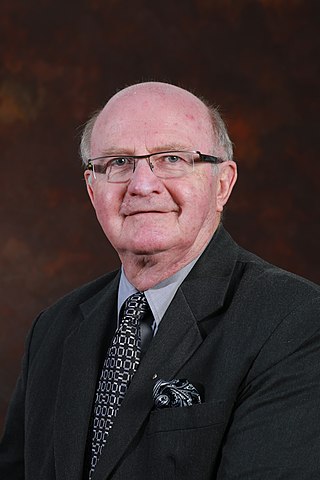Vector Institute may refer to:
- State Research Center of Virology and Biotechnology VECTOR, Russian biology and virology research institute
- Vector Institute (Canada), Canadian artificial intelligence research institute
Vector Institute may refer to:
Vector most often refers to:

Adenoviruses are medium-sized, nonenveloped viruses with an icosahedral nucleocapsid containing a double-stranded DNA genome. Their name derives from their initial isolation from human adenoids in 1953.

Adeno-associated viruses (AAV) are small viruses that infect humans and some other primate species. They belong to the genus Dependoparvovirus, which in turn belongs to the family Parvoviridae. They are small replication-defective, nonenveloped viruses and have linear single-stranded DNA (ssDNA) genome of approximately 4.8 kilobases (kb).

The Uganda Virus Research Institute (UVRI) is a medical research institute owned by the Uganda government that carries out research on communicable diseases in man and animals, with emphasis on viral transmitted infections. UVRI is a component of Uganda National Health Research Organization (UNHRO), an umbrella organization for health research within Uganda.

The State Research Center of Virology and Biotechnology VECTOR, also known as the Vector Institute, is a biological research center in Koltsovo, Novosibirsk Oblast, Russia. It has research facilities and capabilities for all levels of biological hazard, CDC levels 1–4. It is one of two official repositories for the now-eradicated smallpox virus, and was part of the system of laboratories known as the Biopreparat.
Modified vaccinia Ankara (MVA) is an attenuated (weakened) strain of the vaccinia virus. It is being used as a vaccine against smallpox and mpox, having fewer side effects than smallpox vaccines derived from other poxviruses.

Viral vectors are tools commonly used by molecular biologists to deliver genetic material into cells. This process can be performed inside a living organism or in cell culture. Viruses have evolved specialized molecular mechanisms to efficiently transport their genomes inside the cells they infect. Delivery of genes or other genetic material by a vector is termed transduction and the infected cells are described as transduced. Molecular biologists first harnessed this machinery in the 1970s. Paul Berg used a modified SV40 virus containing DNA from the bacteriophage λ to infect monkey kidney cell maintained in culture.

Koltsovo is an urban locality in Novosibirsky District of Novosibirsk Oblast, Russia, located about 10 kilometers (6.2 mi) northeast of Akademgorodok and 20 kilometers (12 mi) southeast of Novosibirsk's center. Population: 15,795; 12,319 (2010 Census); 9,570 (2002 Census); 7,946 (1989 Census).. Total area: 18,8 km2. Koltsovo is a Science town (Naukograd) of the Russian Federation.

Lorne Allan Babiuk, is a Canadian scientist specializing in immunology, pathogenesis, virology, molecular virology, and vaccinology. He is the Vice-President of Research at the University of Alberta and the former Director of the Vaccine and Infectious Disease Organization at the University of Saskatchewan. Dr Babiuk holds the Canada Research Chair in Vaccinology and Biotechnology and is Chair of the Board for Pan-Provincial Vaccine Enterprise (PREVENT), a vaccine development company.

The Ministry of Health and Family Welfare, also known by its abbreviation MoHFW, is an Indian government ministry charged with health policy in India. It is also responsible for all government programs relating to family planning in India.
The National Institute of Virology in Pune, India is an Indian virology research institute and part of the Indian Council of Medical Research (ICMR). It was previously known as 'Virus Research Centre' and was founded in collaboration with the Rockefeller Foundation. It has been designated as a WHO H5 reference laboratory for SE Asia region.
Frederick A. Murphy is a retired American virologist. He was a member of the team of scientists that discovered the Ebola virus at the Centers for Disease Control and Prevention (CDC), where he served as Chief of Viropathology, near Emory University in Atlanta, Georgia, in 1976, and is internationally known for his work on rabies, encephalitis and hemorrhagic fevers, with over 250 peer-reviewed journal articles. Murphy was as an electron microscopy pioneer in the field of virology, best recognized for obtaining the first electron micrograph of an Ebola viral particle at the CDC in 1976.
Geoffrey Lilley Smith FRS FMedSci FRSB is a British virologist and medical research authority in the area of Vaccinia virus and the family of Poxviruses. Since 1 October 2011 he is head of the Department of Pathology at the University of Cambridge and a principal research fellow of the Wellcome Trust. Before that, he was head of the Department of Virology at Imperial College London.

Karl Maramorosch was an Austrian-born American virologist, entomologist, and plant pathologist. A centenarian and polyglot, he conducted research on viruses, mycoplasmas, rickettsiae, and other micro-organisms; and their transmission to plants through insect vectors in many parts of the world. He is the co-author of a textbook on techniques in virology and is the author of numerous papers on the biology and ecology of plant viruses, their hosts, and vectors. He received the Wolf Prize in Agriculture in 1980 for his contribution to the study of crop pathogens.

Zika virus is a member of the virus family Flaviviridae. It is spread by daytime-active Aedes mosquitoes, such as A. aegypti and A. albopictus. Its name comes from the Ziika Forest of Uganda, where the virus was first isolated in 1947. Zika virus shares a genus with the dengue, yellow fever, Japanese encephalitis, and West Nile viruses. Since the 1950s, it has been known to occur within a narrow equatorial belt from Africa to Asia. From 2007 to 2016, the virus spread eastward, across the Pacific Ocean to the Americas, leading to the 2015–2016 Zika virus epidemic.
Synthetic virology is a branch of virology engaged in the study and engineering of synthetic man-made viruses. It is a multidisciplinary research field at the intersection of virology, synthetic biology, computational biology, and DNA nanotechnology, from which it borrows and integrates its concepts and methodologies. There is a wide range of applications for synthetic viral technology such as medical treatments, investigative tools, and reviving organisms.

Zhu Jiming, better known in English as Chi-Ming Chu, was a Chinese virologist. He was a member of the Chinese Academy of Science and an Honorary Member of the American Society for Microbiology.
Mary Katharine Levinge Collins, Lady Hunt is a British Professor of virology and the director of the Queen Mary University of London Blizard Institute. She served as Provost at the Okinawa Institute of Science and Technology in Japan. Formerly, Collins taught in the Division of Infection and Immunity at University College London, and was the head of the Division of Advanced Therapies at the National Institute for Biological Standards and Control, and the Director of the Medical Research Council Centre for Medical Molecular Virology. Her research group studies the use of viruses as vectors for introducing new genes into cells, which can be useful for experimental cell biology, for clinical applications such as gene therapy, and as cancer vaccines.
The Institute of Advanced Virology (IAV) has been established by the Government of Kerala through Kerala Biotechnology Commission (KBC) of Kerala State Council for Science Technology and Environment (KSCSTE) on the wake of the 2018 Nipah virus outbreak in Kerala.

The Wuhan Institute of Virology, Chinese Academy of Sciences is a research institute on virology administered by the Chinese Academy of Sciences (CAS), which reports to the State Council of the People's Republic of China. The institute is one of nine independent organisations in the Wuhan Branch of the CAS. Located in Jiangxia District, Wuhan, Hubei, it was founded in 1956 and opened mainland China's first biosafety level 4 (BSL-4) laboratory in 2018. The institute has collaborated with the Galveston National Laboratory in the United States, the Centre International de Recherche en Infectiologie in France, and the National Microbiology Laboratory in Canada. The institute has been an active premier research center for the study of coronaviruses.